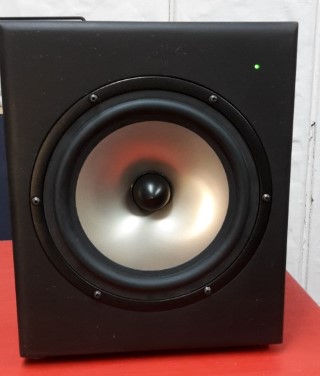
Seas L22 Mk1 (2010)
17. Dezember 2021 - Lesezeit: 7 Minuten
As an addition to the Sphere Seas coaxial system, the bass output should be in a similar performance range and the cabinet should be as small as possible. For use in the living area, the cable clutter should be reduced and the operation should be kept as simple as possible.
I am a friend of optimised systems. The disadvantage of passive crossovers is particularly visible in the bass range with large coils and high capacitor values. That's why I have chosen an active system that also covers the amplification of the tops.
| System | Woofer |
|---|---|
| Topology | active Woofer with EQ |
| System sensivity | 86 dB @1m /2.83V |
| Power handling | 100 watts |
| Impedance | 6 Ohm minimum |
| Crossover | 68Hz 2nd order LR2 |
Ported enclosures definitely cause problems with the sound, as the reproduction mechanism relies on two resonant systems, and it takes time for the sound to build up and decay, especially in the low end.
There are less known options like equalized circuits developed by Linkwitz or Edward Long / Ronald Wichersham. The downside of such systems is a relatively high excursion of the cone and the need of higher amplification power. The benefit, however, is a clean controlled bass response and relatively small enclosures.
For more information I recommend the blog of Rod Elliott (ESP) with an excellent analysis of the subject.
Driver
Cone excursion will be very high at the lowest frequencies, so the speaker needs to be capable of high power, good excursion, and should be at lest in the 8" range (there is no substitute for cone area for moving air at low frequencies).
Since I have had good experiences with SEAS chassis so far, I've chosen a driver from the Prestige Range. The L22RN4X/P has an extremely stiff aluminum cone with good bass precision, phase plug to reduce temperature variations in the voice coil, and an increased power handling capability.
With a moving mass of 40g, I set the upper usable frequency limit to 160Hz, this should fit the design criteria. Calculating around 87dB SPL @ 2.83V we can assume that the efficiency will be less than this below resonance, by a factor of even 6dB or more. Data Sheet: Seas H1208
Enclosure
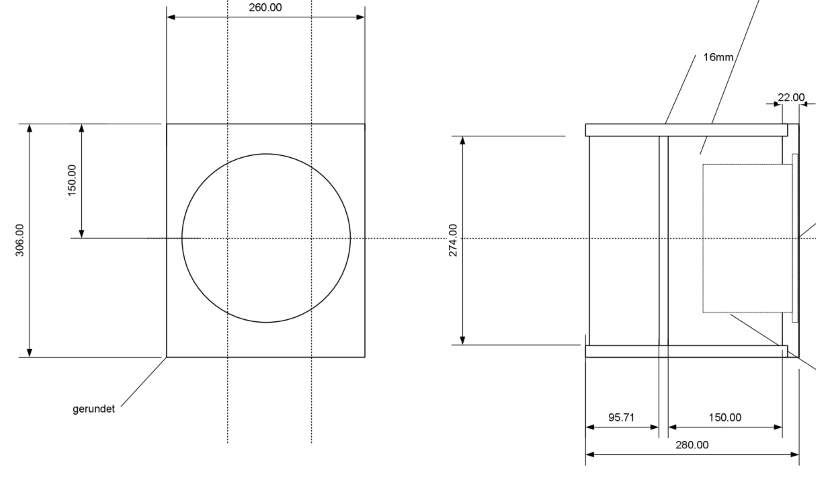 The enclosure is very easy to build, since it is small and sealed, no bracing needed and there is room for the electronic components in the back.
The enclosure is very easy to build, since it is small and sealed, no bracing needed and there is room for the electronic components in the back.
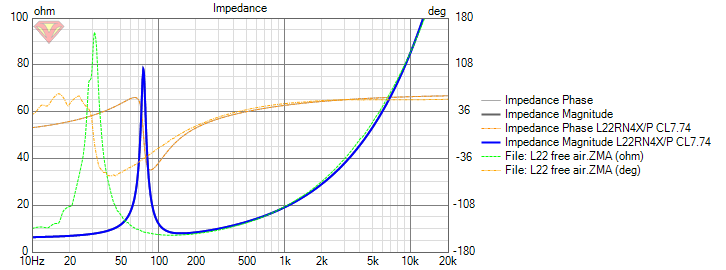 The starting point as usual is the impedance measurement of the woofer in free air (green doted) and in a test cabinet (blue). This allows us to check TS parameters and simulate the system with filters.
The starting point as usual is the impedance measurement of the woofer in free air (green doted) and in a test cabinet (blue). This allows us to check TS parameters and simulate the system with filters.
Crossover
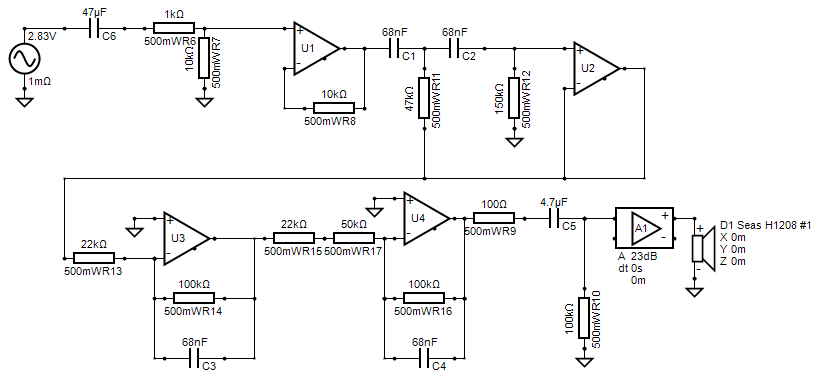 The electronics to perform the necessary filter types are easy to build, with the only hard part was to find a small but suitable amplifier, to drive the System. The schematic shown here has been simplified with regard to the filter curves to such an extent, that it can be used in the CAD program.
The electronics to perform the necessary filter types are easy to build, with the only hard part was to find a small but suitable amplifier, to drive the System. The schematic shown here has been simplified with regard to the filter curves to such an extent, that it can be used in the CAD program.
PCB's are available from Rod Elliot/ESP ( Project 48 rev. A).
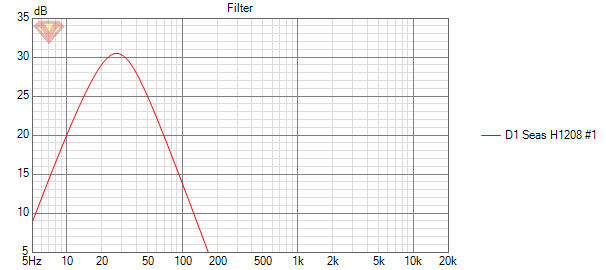
With the modified values of 68nF for C1 to C4 we get a filter curve with a peak around 28Hz. This is perfectly fine for the intended use, and provides a smooth crossover region @ 100Hz.
There are some additional options that can vary depending on the setup and are not shown here.
- The board has only one input, so if you plan to use a normal stereo feed supplying a single P48 board, you'll need to sum the two stereo inputs.
- A phase reversal switch can be used with U1 to properly align the phase to the mid-bass.
- The amplifier stage can be an external unit, or you can use one of Rod's designs. I'm using the TDA7293 D-MOS integrated monolithic IC type, due to the small footprint. It needs an adequate heatsink.
Measurement
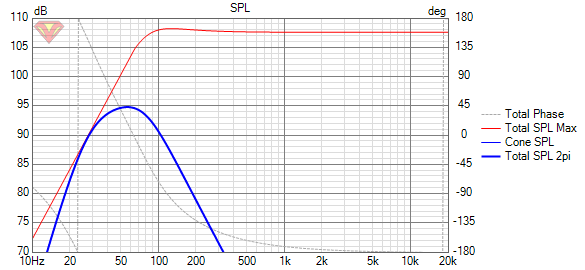 The calculated max SPL with the filters activated.
The calculated max SPL with the filters activated.
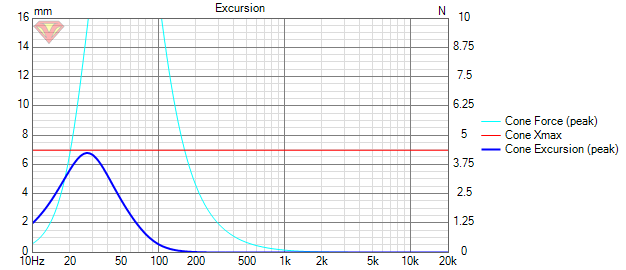 In addition to the pure sound pressure level estimation, we must also take into account the cone excursion and the amplification factor.
In addition to the pure sound pressure level estimation, we must also take into account the cone excursion and the amplification factor.
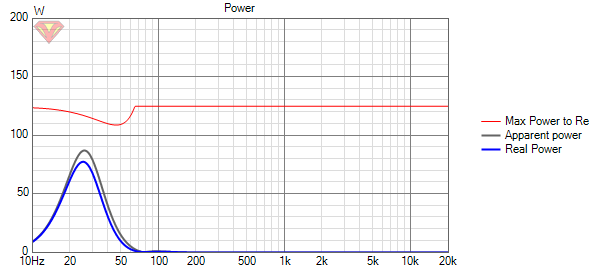
From this figure, we can get away with 100W/8Ohm to push the Woofer to its limits.
Power handling
After completion it is always exciting to compare the live performance with the simulated values.
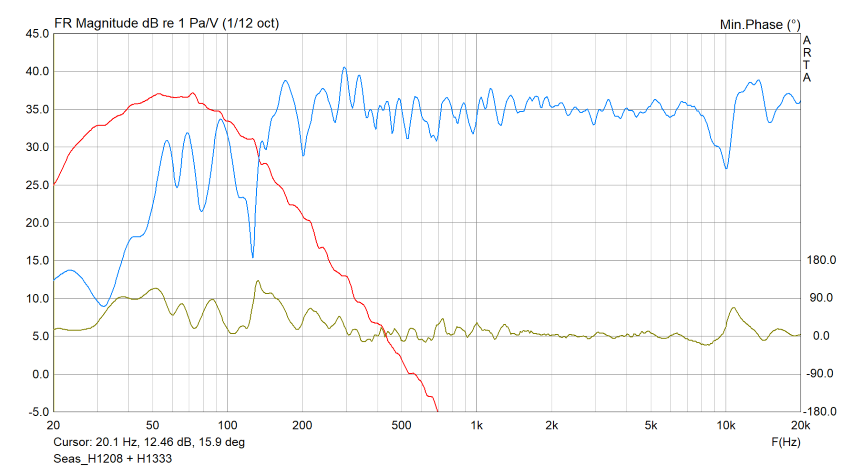 Measured front cone (red curve) gives us almost the exact copy of the SPL simulated curve above. With the LP 12dB/oct it fit's nicely with the Sphere response (blue).
Measured front cone (red curve) gives us almost the exact copy of the SPL simulated curve above. With the LP 12dB/oct it fit's nicely with the Sphere response (blue).
Room placement
Having the freedom to position the woofer independently from the top's, allows a much better optimisation of the low frequency reproduction. For smaller rooms one mono woofer should be sufficient, for medium to larger rooms one woofer per side is recommended.
Summary
As long as the woofer is not pushed beyond its limits, the result is a clean, precise bass that is easy to couple to the main speakers. With the built-in amplifiers, a particularly simple system can be created, which can be controlled from a variety of sources.